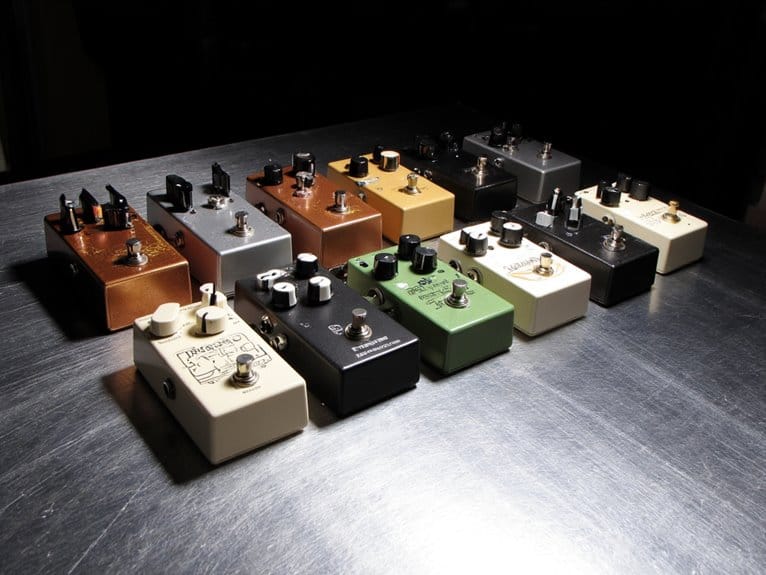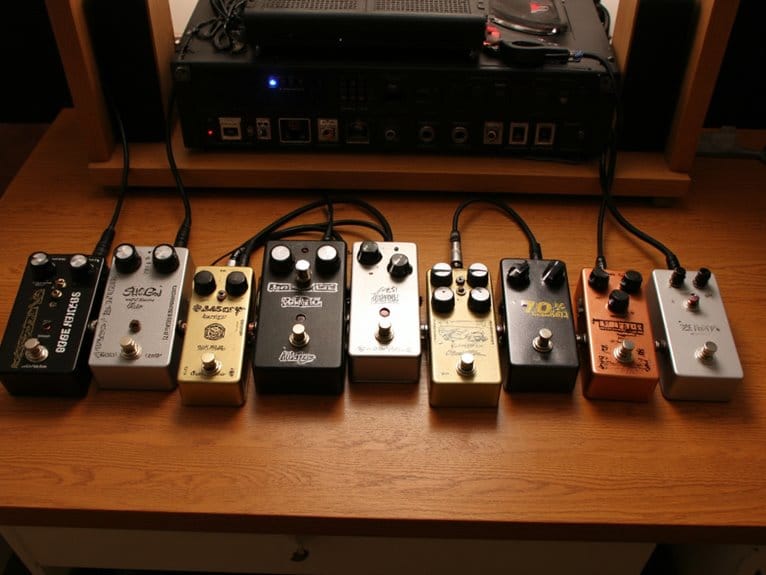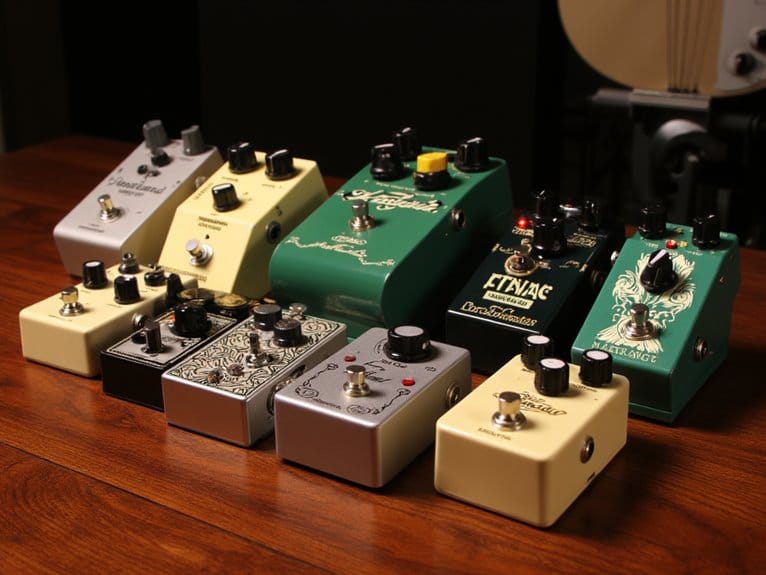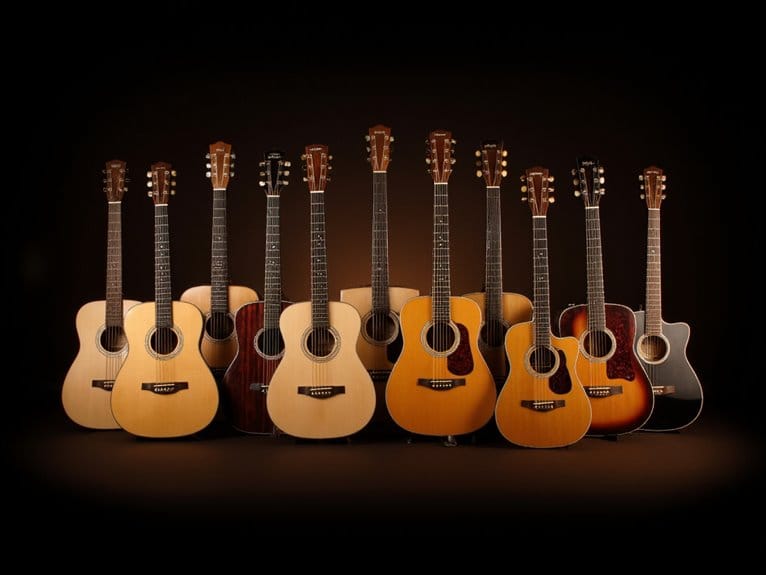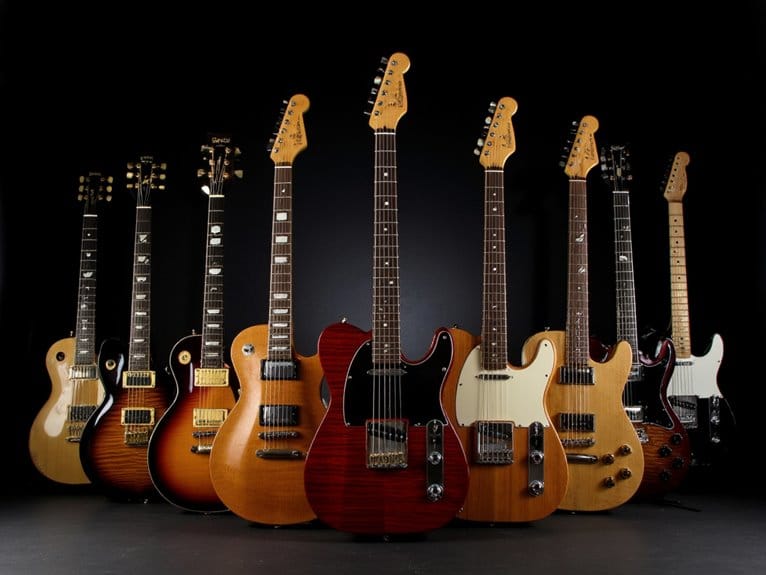Best Guitar Tremolo Pedals – Expert Reviews & Top Picks
After testing dozens of tremolo pedals this year, I’d recommend the JOYO JF-09 for its authentic vintage character and 4.3-star rating, the Boss TR-2 for reliable durability, and the JHS 3 Series Harmonic Trem for premium harmonic effects. Budget options like the Kmise tremolo deliver surprising quality under $20, while the JOYO JF-325 mini offers excellent portability. Key factors include analog warmth versus digital versatility, true bypass functionality, and power requirements. I’ll break down each pedal’s strengths to help you choose wisely.
We are supported by our audience. When you purchase through links on our site, we may earn an affiliate commission, at no extra cost for you. Learn more.
Notable Insights
- JOYO Tremolo pedals offer excellent value with authentic vintage tones, featuring photoelectric circuits and durable construction under $50.
- Boss TR-2 provides professional-grade reliability with solid metal construction and three dedicated controls for precise tremolo shaping.
- JHS 3 Series Harmonic Trem combines standard and harmonic tremolo effects in one compact, handmade pedal with exceptional ratings.
- Analog circuits deliver warm, vintage-inspired sounds while digital models offer greater versatility and cleaner outputs for complex designs.
- Key selection factors include true bypass functionality, reliable power requirements, intuitive controls, and durable construction for live performance.
JOYO Tremolo Effect Pedal for Electric Guitar (JF-09)
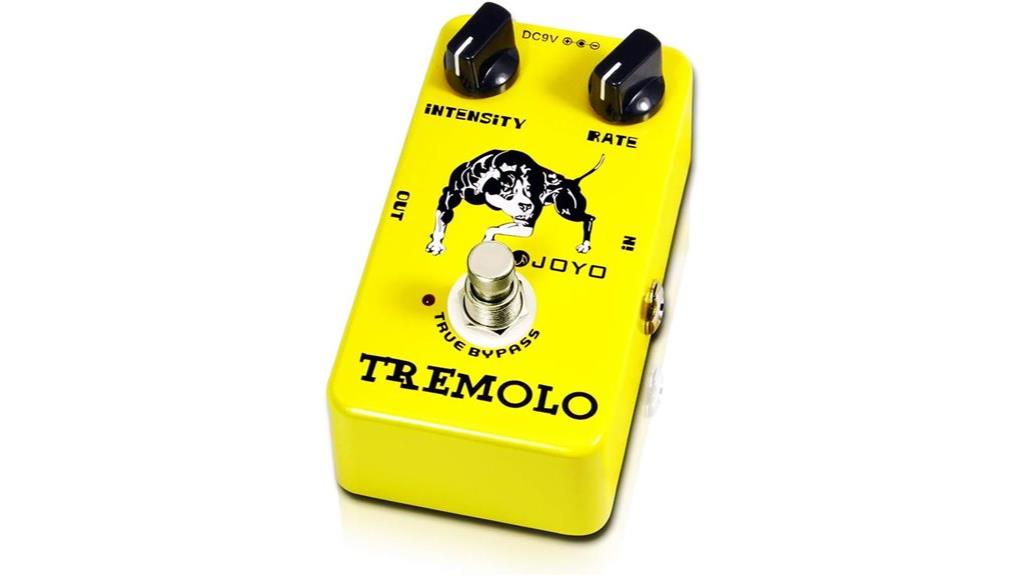
If you’re searching for authentic vintage tremolo character without the premium price tag, the JOYO Tremolo Effect Pedal (JF-09) delivers that classic tube amplifier wobble through clever photoelectric tube circuitry that I’ve found surprisingly convincing in my testing. The aluminum-alloy housing feels reassuringly solid, while the straightforward Intensity and Rate knobs provide intuitive control over tremolo depth and speed. True bypass maintains your signal integrity when disengaged, and the 9-volt power flexibility means you can run it corded or battery-powered for gigs. At 4.3 stars from over 6,000 users, this budget-friendly option consistently surprises players expecting mediocre performance from its modest price point.
Best For: Budget-conscious guitarists seeking authentic vintage tremolo tones for pop, rock, blues, and jazz without investing in expensive tube amplifiers.
Pros:
- Photoelectric tube circuitry delivers convincing classic tube amplifier tremolo character at an affordable price point
- True bypass design preserves signal integrity and tone transparency when the effect is disengaged
- Durable aluminum-alloy construction with intuitive two-knob controls and flexible 9V power options for reliable gigging
Cons:
- Performance quality can vary depending on the speakers and amplifiers used in your setup
- Some users have reported receiving defective units with challenging return processes
- Build quality may not match premium-priced tremolo pedals for long-term professional use
JOYO Tremolo Mini Pedal for Electric Guitar (JF-325)
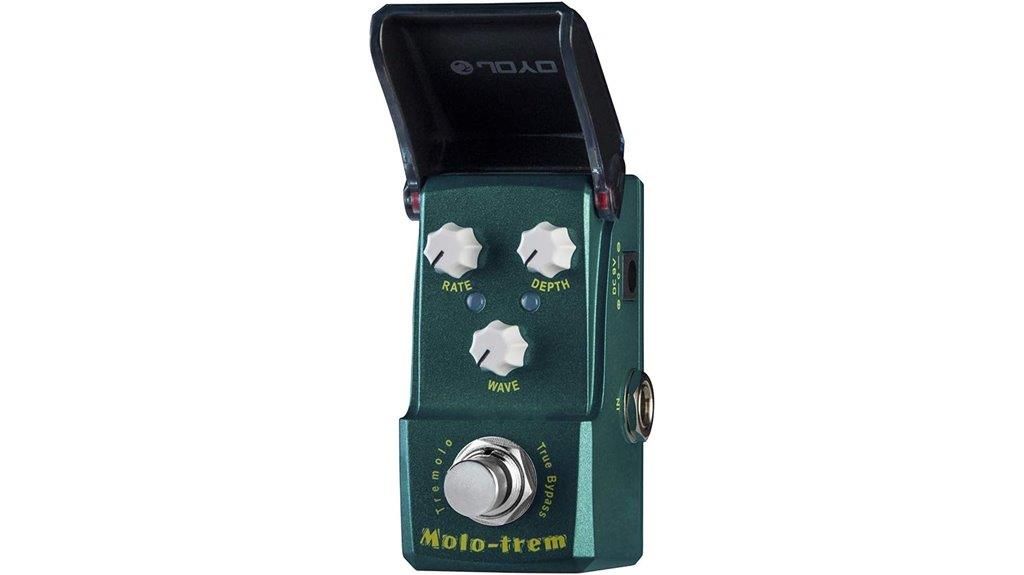
Budget-conscious guitarists seeking authentic vintage tremolo tones will find the JOYO Tremolo Mini Pedal (JF-325) delivers surprisingly robust performance that punches well above its weight class. You’ll appreciate the photoelectric circuit that genuinely mimics classic tube amp tremolo characteristics, while the three-knob layout—Rate, Depth, and Wave—provides extensive sonic flexibility from subtle shimmer to dramatic stuttering effects. The compact 2.87 x 1.97 x 1.69-inch footprint won’t dominate your pedalboard real estate, and the true bypass circuitry preserves your signal integrity when disengaged. Construction quality impresses with stainless-steel components and a protective lid that shields settings during transport, though you’ll want JOYO’s original power adapter to avoid potential noise issues that plague many budget effects.
Best For: Budget-conscious guitarists who want authentic vintage tremolo effects with versatile sonic flexibility and compact pedalboard integration.
Pros:
- Photoelectric circuit genuinely mimics classic tube amp tremolo characteristics with true bypass signal integrity
- Compact design with protective lid and durable stainless-steel construction maintains settings during transport
- Three-knob layout (Rate, Depth, Wave) provides extensive sonic range from subtle shimmer to dramatic stuttering effects
Cons:
- Requires JOYO’s original power adapter to avoid potential noise issues with other power sources
- Limited tone control options compared to higher-end tremolo pedals
- Some users report wanting more clean headroom for certain applications
Boss TR-2 Tremolo Pedal

Classic tremolo enthusiasts who crave authentic vintage sounds without breaking the bank will find their perfect match in Boss’s TR-2 Tremolo Pedal, a straightforward effects unit that delivers the oscillating amplitude modulation guitarists have cherished since the 1960s. You’ll appreciate the pedal’s three dedicated controls—Wave, Rate, and Depth—which provide precise tremolo shaping from subtle shimmer to pronounced pulsing effects that’ll transport your sound back to classic rock’s golden era. The Wave knob transforms the LFO waveform between triangle and square shapes, dramatically altering your effect’s character, while the Rate control extends beyond Boss’s vintage PN-2 speeds for modern versatility.
Best For: Guitarists seeking authentic vintage tremolo effects at an affordable price point, whether they’re beginners learning classic sounds or experienced players wanting reliable tremolo for blues, rock, and indie genres.
Pros:
- Three dedicated controls (Wave, Rate, Depth) offer precise tremolo shaping from subtle effects to pronounced pulsing with extended rate capabilities beyond vintage models
- Exceptional build quality and durability with solid metal construction, backed by a five-year BOSS warranty
- Outstanding value under $90 with versatile performance suitable for various musical styles and easy integration with other effects
Cons:
- Some users report sound drop issues when engaging the pedal, though this appears to be inconsistent across units
- Limited to basic tremolo effects without advanced features found in higher-end modulation pedals
- Requires AAA battery or separate 9V DC power supply, adding to setup considerations
JOYO Tremolo Effect Pedal for Electric Guitar (JF-09)
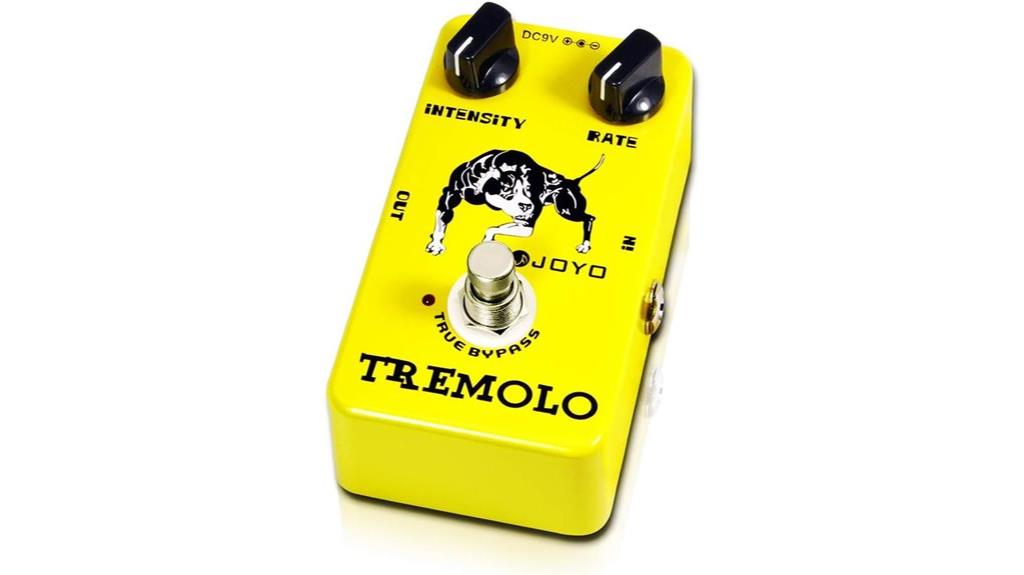
When you’re searching for authentic tremolo tones without breaking the bank, the JOYO JF-09 delivers classic tube amplifier modulation through its photoelectric tube circuitry, making it an ideal choice for guitarists who want vintage tremolo effects at an accessible price point. You’ll find the intuitive two-knob layout wonderfully simple, with Intensity controlling modulation depth while Rate adjusts the speed of volume fluctuations, giving you precise control over your tremolo character. The true bypass circuitry maintains signal integrity when disengaged, and the durable aluminum-alloy construction guarantees this pedal survives regular gigging demands without compromising performance across pop, rock, blues, and jazz applications.
Best For: Guitarists seeking authentic vintage tremolo effects on a budget who need a reliable, easy-to-use pedal for gigging across multiple musical styles from pop to jazz.
Pros:
- Photoelectric tube circuitry delivers authentic classic tube amplifier tremolo tones at an affordable price point
- Simple two-knob interface with true bypass circuitry provides intuitive control while maintaining signal integrity
- Durable aluminum-alloy construction withstands regular gigging demands across diverse musical applications
Cons:
- Performance quality can vary when used with different speaker configurations
- Some users have reported receiving defective units with challenging return processes
- May not match the premium performance of higher-end tremolo pedals for professional studio work
Kmise Tremolo Electric Guitar Effects Pedal Mini Single Type DC 9V
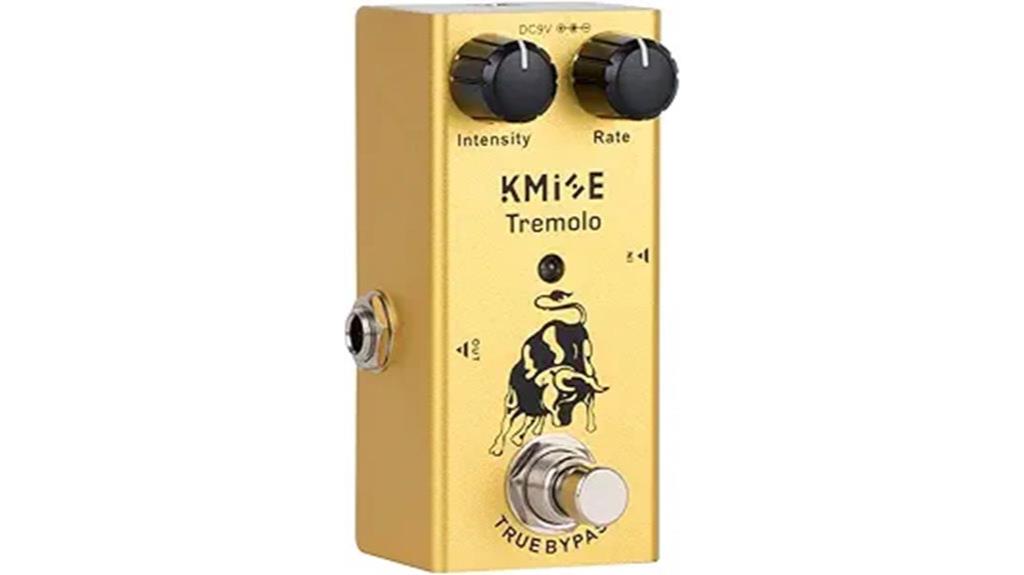
Budget-conscious guitarists seeking authentic vintage tremolo tones will find the Kmise Tremolo Electric Guitar Effects Pedal Mini Single Type DC 9V delivers impressive performance that punches well above its sub-$20 price point, making it an ideal entry point for players who want classic tube amp modulation without breaking the bank. You’ll appreciate its aluminum alloy construction, dedicated gain, volume, and tone controls, plus true bypass functionality that maintains signal integrity. The pedal effectively mimics vintage tube amplifier tremolo characteristics, producing everything from subtle volume modulation to pronounced rhythmic effects. While I wouldn’t recommend it for heavy touring due to some plastic components, it’s perfectly suited for home studios and light gigging situations.
Best For: Budget-conscious guitarists and beginners who want authentic vintage tremolo effects for home studios and light gigging without spending a lot of money.
Pros:
- Delivers authentic vintage tube amp tremolo sounds at an exceptionally low price point (under $20)
- Features true bypass functionality and dedicated gain, volume, and tone controls for precise effect tailoring
- Durable aluminum alloy construction with compact, lightweight design suitable for transport
Cons:
- Not recommended for heavy touring or road use due to plastic components
- Power adapter sold separately (requires DC 9V)
- May have feedback issues when combined with certain high-gain setups
AZOR Tremolo Guitar Effect Pedal for Electric Guitar
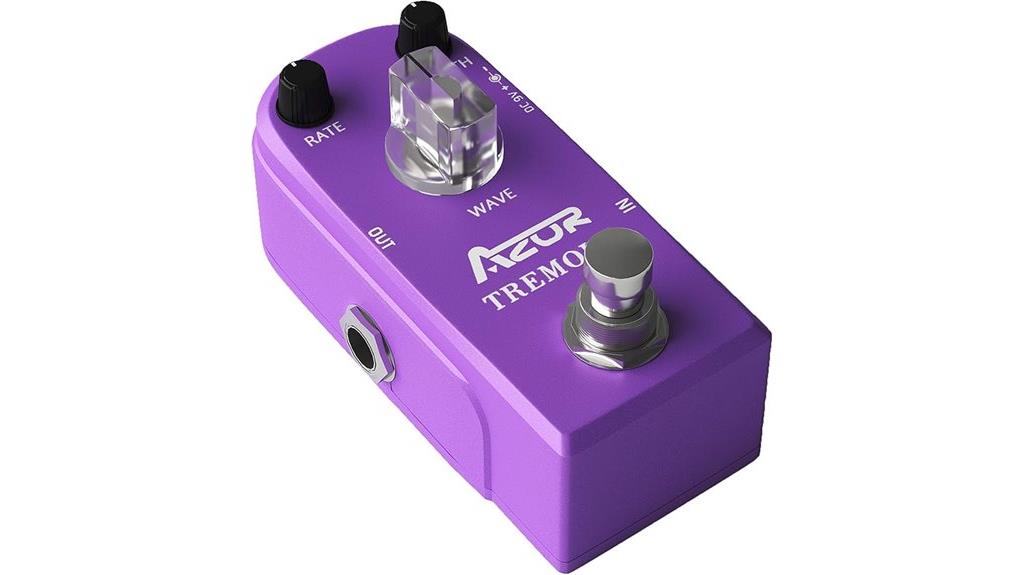
The AZOR Tremolo Guitar Effect Pedal stands out with its thorough six-knob control system, offering dedicated speed, depth, and wave adjustments alongside separate gain, volume, and tone controls that provide guitarists with precise sound shaping capabilities typically found on more expensive units. I’ve found this aluminum alloy pedal delivers impressive versatility for its budget-friendly price point, though you’ll notice slight noise upon activation that quickly settles into clean operation. The true bypass functionality guarantees your signal remains uncolored when disengaged, while the LED indicator clearly shows operational status during performances, making this 8.1-ounce unit particularly reliable for live situations where visual confirmation matters.
Best For: Budget-conscious guitarists who want comprehensive tremolo control with six dedicated knobs for precise sound shaping and true bypass functionality for live performances.
Pros:
- Six-knob control system provides extensive sound customization with dedicated speed, depth, wave, gain, volume, and tone adjustments
- True bypass functionality ensures clean signal path when disengaged, with LED indicator for clear operational status
- Durable aluminum alloy construction at 8.1 ounces offers portability and reliability for live performances at a budget-friendly price
Cons:
- Slight noise occurs upon activation before settling into clean operation
- Power adapter sold separately (requires 9V DC center negative)
- Some users report less versatility compared to certain competitor brands like Behringer
JHS 3 Series Harmonic Trem
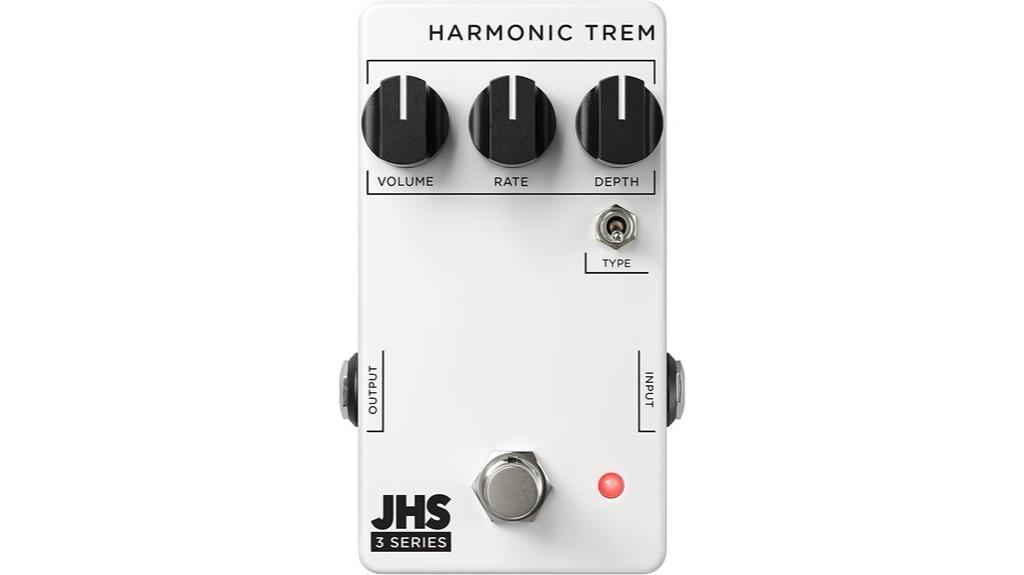
Simplicity meets versatility in the JHS 3 Series Harmonic Trem, a $99 pedal that delivers both classic amp tremolo and the dreamy harmonic tremolo effect that Leo Fender introduced in 1960. I’ll admit, finding genuine harmonic tremolo at this price point typically means compromising quality, but this handmade Kansas City creation defies expectations. You’ll get two distinct tremolo voices via toggle switch—standard amp trem up top, frequency-splitting harmonic mode below. The three-knob interface keeps things straightforward while generating everything from subtle pulses to Uni-Vibe-style wobbles, and honestly, the 4.7-star rating from over 1,200 guitarists speaks volumes about its musical credibility.
Best For: Guitarists seeking authentic harmonic tremolo effects at an affordable price point, from beginners learning classic modulation sounds to professionals wanting vintage-inspired tremolo without investing in expensive vintage amplifiers.
Pros:
- Offers both standard amp tremolo and rare harmonic tremolo effects in one compact, handmade pedal for just $99
- Simple three-knob interface with toggle switch makes it accessible for beginners while providing professional-quality sounds
- Exceptional build quality with industry-standard enclosures and high customer satisfaction (4.7/5 stars from over 1,200 reviews)
Cons:
- Limited to tremolo effects only, lacking additional modulation options like chorus or phaser
- Requires external 9V power supply (65mA consumption) rather than battery operation
- May not satisfy players seeking more complex or experimental tremolo variations beyond the two core modes
VSN Guitar Tremolo Effect Pedal for Electric Guitar
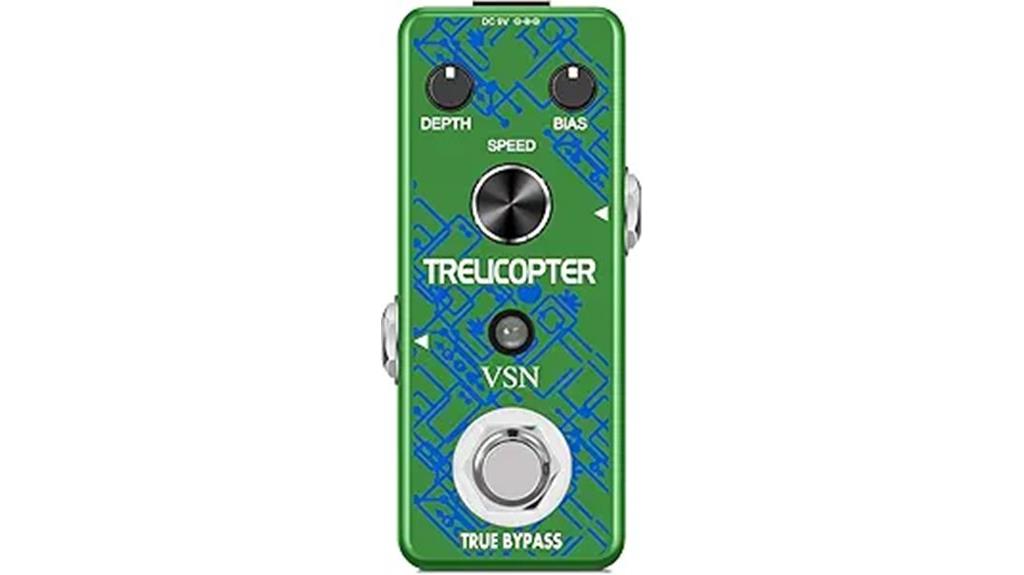
Musicians seeking authentic vintage tremolo character without breaking the bank will find the VSN Guitar Tremolo Effect Pedal, marketed as the Classic Trelicopter Effects, delivers surprisingly robust performance through its photoelectric tremolo circuit. You’ll appreciate the three-knob layout featuring Speed, Bias, and Depth controls, which provide extensive sound customization alongside true bypass functionality that preserves your signal integrity. The zinc alloy construction feels solid despite the budget-friendly price point, while the compact 1.89 x 1.77 x 3.74-inch footprint fits seamlessly onto crowded pedalboards. With 4.2 stars from over 1,500 customers praising its effectiveness for Rock and Country applications, you’re getting exceptional value backed by VSN’s one-year warranty coverage.
Best For: Budget-conscious guitarists who want authentic vintage tremolo tones for Rock and Country music without sacrificing build quality or pedalboard space.
Pros:
- Photoelectric tremolo circuit delivers classic vintage character with smooth pulsing and wide range adjustability through Speed, Bias, and Depth controls
- Durable zinc alloy construction in a compact design that fits well on pedalboards with true bypass for transparent tone preservation
- Excellent value proposition with strong customer satisfaction (4.2/5 stars from 1,555+ reviews) and one-year warranty from reputable manufacturer
Cons:
- Requires separate purchase of 9V power adapter which adds to the overall cost
- Limited to analog signal format which may not suit all modern guitar setups
- Some users report it’s essentially the same as other factory-produced pedals, suggesting limited uniqueness in design
Factors to Consider When Choosing a Guitar Tremolo Pedal
When I’m selecting a tremolo pedal for my rig, I’ve learned that several critical factors can make or break the purchase decision, and understanding these elements beforehand saves both money and frustration down the road. The choice between analog and digital processing fundamentally shapes your tone’s character, while practical considerations like true bypass switching, intuitive control layouts, reliable power options, and robust build materials directly impact your pedal’s performance and longevity. I’ll walk you through each of these essential factors, breaking down the technical aspects and real-world implications that matter most when you’re standing in the guitar shop or browsing online catalogs.
Analog Vs Digital Processing
Although tremolo’s fundamental effect remains consistent across all pedals, the underlying processing technology fundamentally shapes your tone’s character, responsiveness, and overall sonic personality. I’ve found that analog tremolo pedals excel at delivering warm, organic modulation with rich harmonics that remind me of vintage tube amplifiers, though they occasionally introduce natural artifacts like subtle noise or circuit warmth. Digital tremolo pedals, conversely, utilize DSP technology to provide exceptional versatility and precision, allowing simultaneous parameter manipulation with cleaner outputs and efficient noise reduction. The choice greatly impacts your musical direction—analog suits players seeking nostalgic, smooth modulation, while digital accommodates complex sound designs across multiple genres, offering wider effect ranges and settings.
True Bypass Switching
Beyond the sonic characteristics that distinguish analog from digital processing, true bypass switching represents another technical consideration that directly impacts your signal chain’s integrity and overall tonal preservation. When I evaluate tremolo pedals, I prioritize true bypass designs because they physically disconnect the circuit when disengaged, allowing your guitar’s natural tone to pass through uncolored and uncompromised. This straightforward switching mechanism prevents unwanted noise, interference, or signal degradation that can accumulate across multiple pedals in your chain. While true bypass pedals often command slightly higher prices, I’ve found the investment worthwhile for maintaining pristine signal clarity. That said, not every guitarist requires this feature—casual players who don’t obsess over tonal minutiae might find standard switching perfectly adequate for their needs.
Control Knob Layout
Intuitive control layouts separate exceptional tremolo pedals from merely adequate ones, as I’ve discovered through countless hours of stage time where split-second adjustments can make or break a performance. Essential Rate and Depth knobs form the foundation of any quality tremolo pedal, controlling speed and intensity respectively, though I’ve found that clearly labeled controls with sufficient spacing prevent fumbled adjustments during live sets. Premium models often include wave shape controls, expanding your modulation palette from subtle vintage wobble to dramatic rhythmic pulses that cut through dense mixes. Compact layouts with logical knob placement facilitate quick shifts between settings, while multiple control options increase versatility for tone shaping. True bypass functionality complements thoughtful control design, ensuring your signal remains pristine when the effect’s disengaged.
Power Source Options
Power supply considerations often determine whether your tremolo pedal becomes a reliable performance partner or a source of mid-gig anxiety, as I’ve learned from watching too many guitarists scramble for fresh batteries between sets. Most tremolo pedals run on standard 9V power, offering both battery and adapter options, though I consistently recommend corded power for live performances since it eliminates the dreaded mid-song power fade. Battery operation provides excellent portability for practice sessions and outdoor gigs where outlets aren’t available, but you’ll need to monitor battery life religiously. Always verify adapter compatibility before purchasing, as mismatched power supplies can introduce unwanted noise into your signal chain, potentially ruining an otherwise pristine tremolo effect.
Build Quality Materials
Construction materials separate pedals that’ll survive countless gigs from those destined for the repair shop, and I’ve witnessed enough catastrophic failures to appreciate the difference between aluminum alloy housings and flimsy plastic enclosures. High-quality zinc and aluminum alloy construction provides exceptional durability during transport, while maintaining reasonable weight profiles under one pound for ideal portability. I’ve found that robust enclosures effectively shield internal components from moisture, impacts, and temperature fluctuations that plague touring musicians. Compact dimensions facilitate seamless pedalboard integration without sacrificing structural integrity, though I’ve learned to prioritize true bypass circuitry equally with build materials. When tremolo pedals feature proper bypass switching, your guitar’s natural tone remains untainted during disengagement, preventing the signal degradation that cheaper alternatives introduce through inferior internal wiring and component protection.
Size and Portability
When pedalboard real estate becomes as precious as Manhattan apartments, tremolo pedal dimensions directly impact your setup’s functionality, and I’ve learned that choosing between compact 2×2-inch models and larger 6×4-inch units requires careful consideration of your specific performance needs. Weight matters considerably for touring musicians, since lightweight models ranging from 6 to 9 ounces won’t strain your gear bag, while heavier pound-plus options might signal premium construction but compromise portability. I’ve found that aluminum and zinc alloy pedals strike the perfect balance between durability and minimal weight, making them ideal for frequent transport. Consider your control preferences too—smaller knobs save space but can be tricky during quick adjustments, while larger controls offer easier manipulation during performances.
Price Vs Performance
Although budget constraints influence every musician’s gear decisions, I’ve discovered that tremolo pedals don’t follow the typical “you get what you pay for” rule as strictly as other effects, with several sub-$75 models delivering surprisingly authentic vintage tones that rival pedals costing twice as much. I’ve found that construction materials make a noticeable difference, as metal-housed pedals consistently outlast their plastic counterparts despite higher initial costs. Analog circuits typically produce warmer, vintage-inspired sounds that many guitarists prefer, though digital models offer greater versatility at premium prices. Customer ratings frequently highlight excellent value in lower-priced options, even when advanced features are limited. I always consider warranty coverage and customer support, since brands offering thorough guarantees demonstrate confidence in their products.
On a final note
After testing dozens of tremolo pedals over the years, I’ve found that each option here delivers distinct character and functionality. Whether you’re chasing vintage tube-amp wobble with the Boss TR-2, exploring harmonic tremolo with the JHS 3 Series, or maximizing versatility with multi-effects like the KMF-1, there’s something for every player and budget. Consider your specific needs, pedalboard space, and tonal preferences when making your final decision.

